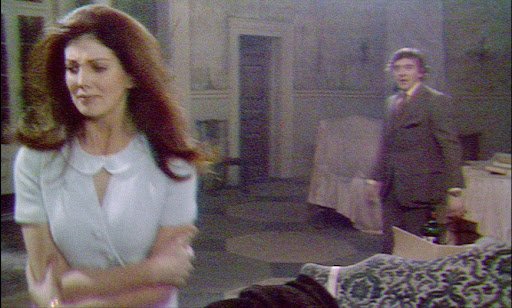
Voices (1973)
“We’ve been alone too long. This house is beginning to talk to me…”
Hmmm, horror film, only child, water… where have we seen this before?
Whatever your reference, it’s pretty clear that – don’t look now, but - on this family boating holiday, things aren’t going to go well (and they don’t). But first we’ve got half a pineapple, a load of bananas and a bottle of Blue Nun for lunch - what more does a middle class 70s family unit need? (“Is this to eat or to look at?”)
The Blue Nun works its sexy magic, and before you can say “excellent parenting”, loved-up couple Robert (David Hemmings) and Claire (Gayle Hunnicutt) have packed young son David (Adam Bridge) off to play with someone else’s dog next to a cold-looking raging torrent of water, while they have a spot of boat-based nookie.
Suffice to say, that’s the last we see of young David. Cue every parent’s nightmare as we endure queasy scenes following the pair on a fruitless search.
There’s a jump in time and we’re back with Robert and Claire as they drive through a heavy fog towards the country property Claire has inherited from an aunt.
Given they’re in a distinctly un-family friendly MGB GT (those back seats were for show only, take it from a 70s child whose mum had one), it follows that young David was never found, and such proves to be the case. Claire took the loss badly (flashbacks show her suicide attempts and subsequent hospitalisation), Robert, in the tradition of dads at the time, not so much.
As they bicker and banter on the journey, there’s a couple of near misses courtesy of the fog / poor quality of headlamps of the time juxtaposition, but they eventually arrive at their destination.
And it’s at this point the film plays the odd card which sets it apart from its contemporaries. Remember, this is a “proper” film, meant for (and getting) a cinema release. And up until we enter the front door, it has clearly been shot on film, as befits such a project. But inside the house itself, we suddenly, and jarringly, switch to video.
“I feel strange” says Claire, and she’s not alone. This choice works… it feels like things are different in the house. The subsequent 50 years have shown us that there is something otherworldly about video, whether it is scary stuff from the 70s (The Stone Tape), later “found footage” projects, or retro scares (Inside Number 9 exploited it with The Devil Of Christmas). So well done, production team, for realising this as far back as 1973. What contemporary audiences thought of it though, I can only wonder. Did they even notice?
The experience has shaken Claire, who throughout has looked fragile and haunted, but now really starts to unravel. “We could have died out there, we could have! People die in the fog!”
But while she is pleading with her husband that something is wrong, all he appears interested in is sex.
Then she starts to hear ghostly children, giggling…
As we learn more about the relationship (he asserts that Claire’s relationship with their son was not healthy, she reminds him he had an affair), what appear to be Claire’s ghostly imaginings become more real. She starts to see the children, and their mother, and they might even be seeing her, too.
The couple also start to physically fight, and it’s worth remembering here that at the time, Hemmings’ and Hunnicutt’s real-life marriage was on the rocks – and those slaps and punches look like they are really connecting. What’s more, when Mr 70s man gets his way and sex ensues, it’s certainly not pleasant for either of them, or the viewer, despite Claire’s brittle insistence that it marks a new start for them.
Ghostly “Voices” are scary, and here are made more unsettling by the shot-on-video “reality” of the interior scenes. But ultimately Voices is what it is, a stagey two-hander which hinges on one of the oldest “twists” in the book.
